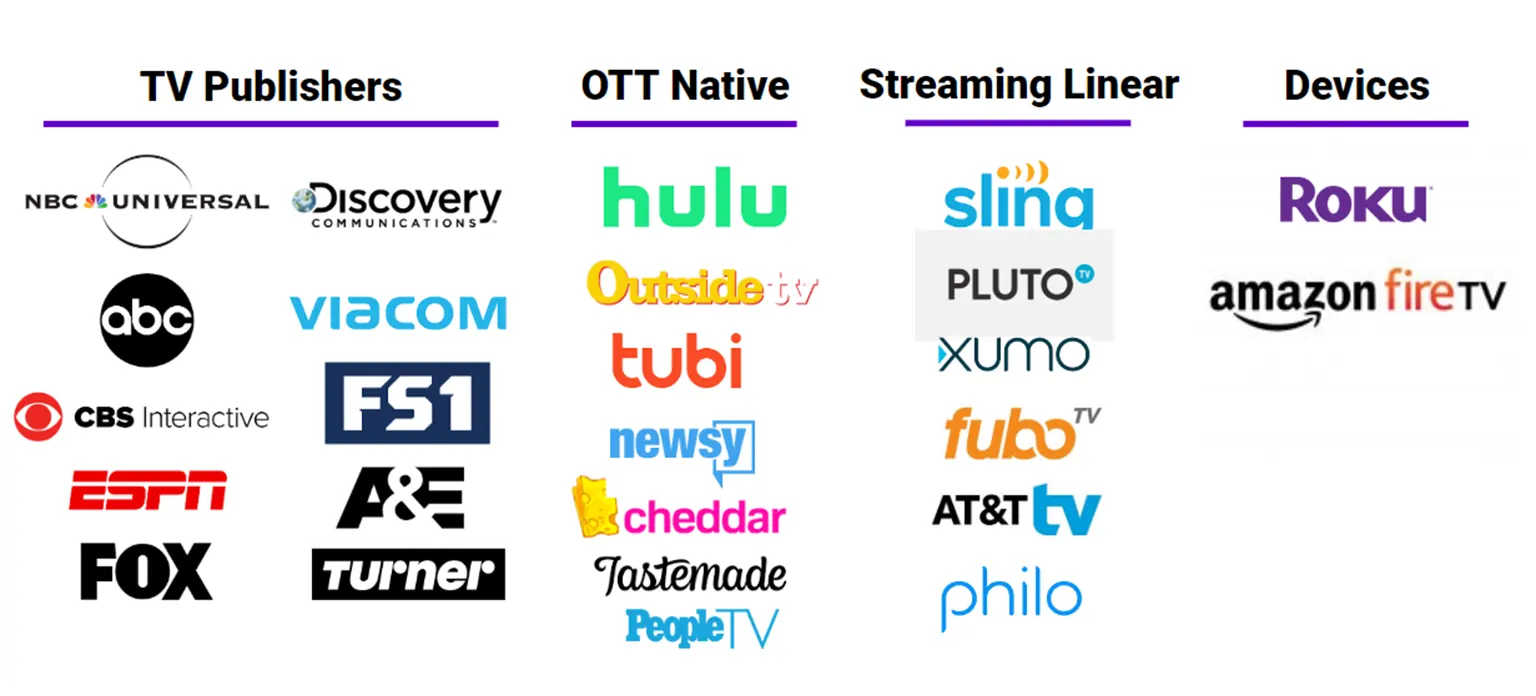If you’ve ever binge-watched a show on Freevee, watched a live event on Twitch, or used Fire TV to view your favorite network broadcast app, you’ve encountered over-the-top (OTT) video content. Any programming that is provided directly to consumers over the Internet by a streaming video service, avoiding the conventional cable set box and usually seen on a TV is referred to as over-the-top, or “streaming TV.”
These video content’s commercials are referred to as over-the-top (OTT) advertising or streaming TV ads. As more people shift away from traditional cable and broadcast TV in favor of streaming video content, OTT, or streaming TV, advertisements present a chance for advertisers to reach new audiences at scale.
This article explores the intricacies of over-the-top (OTT) advertising, examining how it functions in 2024 and the reasons it’s becoming an important part of current digital marketing tactics.
Over-the-top, or OTT, advertising reaches viewers directly via the internet via streaming video services or devices. Media buyers can target specific audience segments through this channel, which also offers the sophisticated measurement tools that digital marketers have been accustomed to.

The capacity to get beyond traditional TV providers that manage media distribution and assist marketers in directly reaching their target audiences is what gives rise to the phrase “over-the-top.” Media firms (and advertising) can move freely when they go over the top because there are no fixed broadcast schedules or regional restrictions.
Users can see OTT advertising on a variety of devices, such as PCs, smartphones, game consoles, smart TVs, and any other device that allows them to access streaming services. While over-the-top (OTT) advertisements come in a variety of forms, they are often of a good caliber with distinctive branding and messaging.

What is the Difference Between OTT and CTV Marketing?
Although OTT and CTV are frequently used synonymously, there are a few key distinctions between the two, which are listed below:
The delivery mechanism known as over-the-top (OTT) feeds content to desktop and mobile devices alike.
The gadget used to watch OTT material is called a connected TV, and it’s generally a smart TV.
There are two methods available for watching material on a connected TV:
1. Standard TVs that are linked to streaming media players such as Roku, Apple TV, Amazon Fire Stick, and Chromecast, enabling you to watch over-the-top (OTT) and cable television (CTV) programming online.
2. Smart TVs are regular TVs with built-in internet access.
In addition to being accessible on TV, OTT material may be accessed on any internet-connected device, including laptops, desktops, tablets, and mobile phones. We prefer to watch this content on television because it provides a better experience for both watching and advertising.
If the OTT/CTV distinction is still a little unclear to you, consider services like Hulu, Netflix, Amazon Prime Video, and Roku, where all you really need is WiFi to get your preferred TV programming.


1. Content that is Original and Unique
You’ve probably noticed that OTT channels like Netflix and Amazon Prime TV have a lot of original material available only to them. Customers will find it easier to get your material because it is exclusive, and you will also be able to keep your loyal customers.
2. Excellent Content at a Reasonable Price
Compared to traditional cable bundles, media streaming services offer a clear advantage. Not only can you view thousands of films, TV shows, and documentaries at affordable prices, but you can do it at your convenience. All you need is a gadget that can connect to WiFi and a dependable internet connection.
For example, Netflix only charges eight dollars for a regular membership and twelve dollars for its HD bundle per month.
3. Various Compatibility
As opposed to traditional broadcasting, you can watch your favorite shows without always having a TV. as long as you’re using any kind of Wi-Fi and internet-connected device. To get started, simply download the required programs and register with the particular service.
Additionally, you can share an account across several devices, albeit some firms do not allow this feature. Among the gadgets that support OTT streaming are:
• Cell phones
To access OTT services, cellphones running Android and Apple software can be downloaded.
• PersonalComputers
OTT services can be accessed on Mac and Windows computers using a variety of apps and web browsers.
• Smart Televisions
The latest generation of smart TVs enables you to download TV-compatible apps, such as OTT apps, directly to your TV.
• Standard Televisions
TVs with USB connections can be upgraded to smart TVs by adding TV sticks or smart boxes, which will let them access OTT services.

Everyone involved benefit from over-the-top (OTT) advertising. Because they may access a variety of content without the restrictions and expenses of traditional TV subscriptions, consumers value it. Because of its addressability, which enables companies to provide customized creative, target certain households for their campaigns, and deterministically link their TV advertisements to business outcomes that occur on other platforms, advertisers find it appealing.
Additionally, OTT offers advertisers the following advantages:

More Involved Viewers
98% of people who use OTT devices watch commercials through to the end. Similar to traditional TV, users are unable to easily navigate between tabs in their browsers, ignore OTT advertisements, or use ad blockers. This guarantees that more people will see an advertisement and that they will be more inclined to follow them through to the end.
Superior Targeting Capabilities
A high degree of audience targeting is quite possible, regardless of whether OTT video is viewed on a desktop, connected TV, or mobile device. Combinations of survey responses, website and app surfing patterns, and information gathered during registration by linked TV apps can be used to create audience targeting pools.
Device mapping within a household facilitates data stitching across devices, enabling person-level targeting within a household on shared equipment like a linked TV. This method provides insightful information on the viewing patterns of viewers, enabling advertisers to target based on individual preferences and actions.
Attribution
Because there isn’t a direct “click” like there is in traditional web advertising, advertisers have previously found it difficult to gauge the direct impact of OTT ads, particularly on CTV devices, on lower-funnel KPIs. New technologies are helping to close this gap by successfully connecting CTV advertising campaigns to tangible business results. How? The CTV attribution model looks at the IP addresses that are exposed to CTV advertisements and uses the website pixel inside the designated attribution window to tie those IP addresses to the IP addresses deterministically.
Optimization in Real Time
With the help of new technologies that provide real-time data on the effectiveness of over-the-top (OTT) ads, advertisers may allocate budgets instantly. They can modify expenditure for ineffective areas and prioritize ad spend on applications, dayparts, or creatives that are generating better results. Consider our engine for Automated Performance Optimization. Brands install the Pixel on their website or app, and TV+ uses real-time tracking of the web to feed the APO engine, which automatically optimizes the targeting and budget allocation approach.
Top Tier Inventory, Fraud Free, and Brand Safe
Even the most powerful advertising lose their impact when they are served on poor-quality inventory, which is also a major waste of marketing funds. The overwhelming majority of advertisers concur that this is a key worry for any business: We have only chosen premium TV networks that we are certain will complement your brand, captivate to your target market, and be especially well-chosen to boost results.
The process of OTT advertising consists of multiple steps. Below is a high-level summary of what to anticipate:
Planning: Get to know your target audience by learning about their demographics, interests, viewing habits, and other details. This will make it easier for you to plan your OTT advertising campaign.
Producing material: The following phase entails producing pertinent, interesting material that will appeal to your target market. These could be quick clips, ads, or promotional videos.
Choosing OTT Platforms: Hulu, Roku, and other similar platforms are examples of OTT platforms where your ads will appear. By using an advertising platform, you may run your commercials across a number of comparable streaming services that accept adverts.
Buying Ad Space: You must purchase ad space after deciding on your platform or platforms. This can be accomplished either directly through the platform or through programmatic advertising, which automates the placement, purchase, and optimization of media inventory using artificial intelligence.
Audience Segmentation: You may be extremely specific about who sees your ads when using over-the-top (OTT) advertising. Your audience can be divided into groups according to their demographics, interests, or actions.
Establishing the Campaign: The next step is to set up the campaign on the OTT platform after you’ve bought ad space and divided your audience. This entails deciding when and where to display your advertisements.
Launching the Campaign: Your campaign is prepared for launch after all the necessary setup has been completed. Your target audience will now see your adverts on the OTT platform(s).
Keeping an eye on the campaign: Monitor the results of your campaign. This can entail monitoring important data such as conversion, click-through, and view-through rates.
Enhancing the Ad Campaign: You might need to tweak your campaign based on how well it performs. This might be making changes to the scheduling, the ad content, or the audience segmentation.
Reporting: Following the campaign’s completion, it is crucial to compile an extensive report summarizing its success—or lack thereof. Future campaigns can benefit from the knowledge in this study.
When displayed on TV screens, over-the-top (OTT) advertising functions similarly to other
direct response channels, but it offers an immersive experience that is exclusive to the medium.
Different OTT advertising platforms, allow brands to set up audience targeting, track who is viewing an advertisement, and then see how this compares to their other digital marketing services
efforts. We go into more detail about the types of OTT in the section below.
Additionally, it is cross-device compatible, which means that after a consumer watches an OTT ad, the platform follows them to your brand’s website until they make a conversion.


Types of OTT Ads
Over-the-top (OTT) advertisements can be distributed via online streaming media in a variety of methods. The most typical OTT ad formats are:
1. Pre-roll advertisements: They are brief commercials that run before the main content starts. Generally, they last 15 to 30 seconds.
2. Mid-roll advertisements: These are placed in the midst of the video, usually after a certain length of time. They can last anywhere from 30 seconds to several minutes, and they are typically longer than pre-roll advertising.
3. Post-roll advertisements: These run following the conclusion of the main program. They can last anything from a few seconds to many minutes, and they are frequently lengthier than pre-roll advertising.
4. Banner ads: Small advertisements known as banner ads might show up at the top or bottom of the screen while information is being displayed.
5. Overlay adds: Overlay advertisements are those that show up over the content without interfering with the watching experience. They can direct users to a landing page and are frequently clickable.
OTT advertising gives marketers a variety of ways to connect with consumers via streaming media. Every form of advertisement has benefits of its own and may be applied in many ways to draw in viewers and produce desired outcomes.


On-Demand Video that Requires a Subscription (SVOD)
A recurrent membership charge is required for customers of subscription-based video on demand (SVOD) services in order to access a library of video content, which includes TV series, films, and original content. SVOD systems provide consumers with uninterrupted commercial-free access to their entire library of content.
SVOD services include, for example, Netflix, Hulu, Amazon Prime Video, and Disney+.
Video on Demand with Advertising (AVOD)
The concept of video on demand (AVOD) is the provision of video content via the internet at no cost to users, with advertising serving as the primary source of income. Under this arrangement, advertisements play while the viewer is not charged for the content. The content’s creation and delivery are funded in part by the money received from the advertisements.
YouTube, Crackle, and Pluto TV are a few AVOD platforms.
On-Demand Video Transactions (TVOD)
One kind of video-on-demand service that lets users access content on a pay-per-view basis is called transactional video on demand, or TVOD. TVOD allows users to buy or rent specific films or TV series, and usually gives them a predetermined amount of time to watch the media before it expires. TVOD is frequently utilized for one-time events like concerts or athletic events, as well as for more recent releases that aren’t yet accessible on subscription-based platforms.
Google Play, iTunes, and Amazon Prime Video are a few examples of TVOD platforms.
Premium Video on Demand (PVOD)
A video distribution model known as Premium Video on Demand (PVOD) allows consumers to rent or buy recently released films or television series before they become available on traditional physical media like DVDs or Blu-ray discs or subscription-based video on demand (SVOD).
Instead of demanding to wait for the content to become accessible on other platforms or visit the movies, PVOD allows users to watch high-quality video content in the comfort of their own homes. PVOD rentals are typically offered at a premium pricing point, generally for a shorter duration than 48 hours, and at a higher cost than renting the same title through regular video-on-demand (VOD) platforms.

1. Roku: In the OTT market, Roku is a pioneer. With more than 51.2 million active accounts as of the first quarter of 2021, it has a sizable user base. Roku’s own data indicates that they reach more than 70 million US households, which makes them a very powerful platform for advertising. Roku is a flexible option for advertisers because it provides a wide variety of ad forms, such as display ads, video commercials, and interactive ads.
2. Hulu: As of 2021, Hulu had over 41 million American subscribers, making it one of the most well-known streaming services. Businesses may reach a wide audience by using pre-roll and mid-roll commercials, among other ad formats, via Hulu’s ad-supported tier, Hulu Ad Manager.
Advertisers can target particular viewer segments with their content thanks to Hulu’s demographic targeting feature.
3. Amazon Fire TV: With an estimated 50 million users in the United States, Amazon Fire TV is a major player in the over-the-top (OTT) market. Advertisers may successfully target their advertising by utilizing Amazon’s huge user data. Amazon Fire TV offers a range of ad types that allow advertisers to customize their campaigns, such as interactive, display, and video adverts.
4. YouTube TV: With millions of users, YouTube TV is an extension of the YouTube platform. A variety of ad formats are available on YouTube TV, one of which is in-stream advertising, which are engagement-guaranteed video ads that cannot be skipped. YouTube is a powerful medium for advertising due to its large user base and wide audience reach.
5. Disney+ and Other Premium Streaming Services: In just their first year of launch, premium streaming services like Disney+ attracted millions of customers, demonstrating their quick development.
Because of their reputation for producing high-caliber content and having a loyal audience, these platforms appeal to marketers who want to reach particular target audiences.
In order to ensure brand alignment with popular content, premium services frequently offer chances for native and sponsored content integrations.
6. Programmatic Advertising Platforms: Tools for automated, data-driven advertising across many OTT platforms are offered by programmatic advertising platforms such as MediaMath, The Trade Desk, and Beeswax. These platforms give advertisers access to a large variety of over-the-top (OTT) inventory, facilitating the expansion of their audience reach and enabling real-time data-driven campaign optimization.
7. Social Media Platforms: By extending their reach through their current ad ecosystems, social media platforms like Facebook and Instagram have made inroads into the over-the-top (OTT) market. These platforms provide valuable user data access and alternatives for targeted advertising. Because of their large user bases, flexible ad formats, and ability to target specific audiences, these platforms have become more and more prominent in the OTT advertising market.
Your company’s target demographic and campaign objectives should be taken into consideration when selecting an OTT advertising platform. To make sure that your advertising investment is maximized, it’s critical to evaluate the reach, ad formats, and targeting capabilities of each platform.

You can start your OTT campaign in four easy steps as long as your ads are made according to the correct specifications:
1. Upload the creative for your advertisement.
2. Decide on your targeting specifications.
3. Use relevant advertisements on all of your other devices to make your campaign memorable and help people remember your brand.
4. Decide on your launch date, campaign objectives, and budget.

What Types of OTT Campaigns Can You Run?
Depending on the OTT campaign approach you select, some advertisers provides a solution for both:
Performance TV Prospecting: To focus or expand your targeting, use our collaboration with top data supplier Oracle Data Cloud to access over 85,000+ third-party audience segments.
Performance TV Retargeting: Serve OTT advertising to consumers who have expressed interest in your brand based on your own first-party CRM data.


How Do I Buy OTT Ads?
There are two ways to purchase OTT ads:
Direct purchase via a publisher: Also referred to as “walled gardens,” these enclosed ecosystems—like Amazon Prime Video—have predetermined prices and operate independently.
Programmatic buys: Normally priced less than direct buys, these are real-time bids placed across a network of over-the-top (OTT) advertising inventory.
What Is the Cost of OTT Advertising?
One of the best and most economical ways to reach viewers who are switching from traditional linear television to streaming TV is through OTT platforms. The number of businesses that can participate in traditional TV advertising is severely limited due to the large upfront outlay required.
OTT advertisements, on the other hand, are available for purchase on a month-to-month basis, allowing customers to distribute their advertising budget across several campaigns with varying goals.
Furthermore, when it comes to targeting particular populations, your money will go a lot farther with OTT advertising than with cable TV advertising. Performance marketers are increasingly allocating their ad spend to Connected TV and OTT, with targeting choices and conversion monitoring that surpass the limitations of linear.

OTT advertising is fundamentally a digital ad media, and its success is evaluated using standard KPIs and metrics from digital marketing. These are a few essential ones that everyone should be aware of, particularly if they want to employ OTT advertisements for performance marketing campaigns.

Ad Impressions: A tally of all the advertisements that viewers have seen, indicative of the campaign’s reach.
Return on Ad Spend (ROAS): A crucial indicator that illustrates the proportion of money made to all of the money you spent on ads in your campaign.
Cost per Completed View: How much on average your campaign’s budget is used for each fully watched advertisement.
Cost per Acquisition, or CPA: The average expense your campaign bears for each successful acquisition, like a sale or form signup, is known as cost per acquisition, or CPA.
Audience Reach: The proportion of distinct people in your target market who have seen your over-the-top advertisement.
Frequency: The average number of times a particular person sees your advertisement; this helps to avoid overexposure to the same ad.
GRP (Gross Rating Point): An old-fashioned indicator called GRP (Gross Rating Point) measures the percentage of your target audience that has seen your advertisement.
CPP (Cost Per Point): Cost Per Point, or CPP, is a metric used to evaluate how cost-effectively your advertisements reach the people you want to reach.
Cross-Screen Measurement: A metric that makes it possible to monitor and assess how much time users spend watching videos on different platforms, such as desktop, TV, and mobile.
Target Rating Point: The percentage of your targeted potential customers that view your advertisements, important for a successful campaign.
OTT Marketing Best Practices
In the digital age we are living in, over-the-top (OTT) marketing is an essential way for brands to interact with their audiences, especially as more customers switch to streaming services. Using efficient techniques in your over-the-top (OTT) advertising can increase reach, stimulate interaction, and increase conversions.
Know Your Demographic: The first step in developing a successful over-the-top (OTT) campaign is identifying your target demographic and then crafting content that will appeal to them.
Make the Most of Audience Segmentation: To segment your audience and present tailored advertisements, use behavioral, regional, and demographic data.
Produce Superior Content: In order to grab and hold viewers’ attention, make sure your advertisements are compelling and well-produced. Keep the caliber of your content high.
Choose Cross-Platform Advertising: Increase the total exposure of your campaign by connecting with your audience on a variety of platforms and devices.
Measure and Optimize: Keep a close eye on the effectiveness of your campaigns to determine what is and is not working, then adjust your optimization accordingly.
Add a Clearly Stated Call-to-Action (CTA): Make sure every advertisement has a strong call to action (CTA) to persuade visitors to click on it.
Make Your Adverts Contextually Relevant: To improve relevance and viewer engagement, try to match your adverts, if at all possible, with the content that is being streamed.
OTT Advertising Examples
Businesses utilize a plethora of excellent OTT ad examples for their performance marketing efforts. Check out a handful of our top picks!
Rumpl
With this amazing commercial, Rumpl decided to try out OTT advertising, showcasing their incredibly stylish and incredibly warm blanket made from recyclable materials. It’s a fantastic advertisement that grabs your attention right away and appeals to the spirit of the adventure-seeking tourist.
Replacements
Replacements is the place to go if you enjoy stylish and sophisticated dining table décor. This over-the-top example follows a tried-and-true formula: in less than 30 seconds, it should explain a common problem, offer a solution, and make the value proposition. Just how viewers like it: brief and delicious.
1Password
Alright, let’s use Ryan Reynolds for another example. It’s true that he’s a fairly entertaining man. Using 1Password, an innovative cybersecurity password manager, you can safeguard all of your digital data with this over-the-top advertisement. This is yet another direct, humorous, and endearing video creative.

